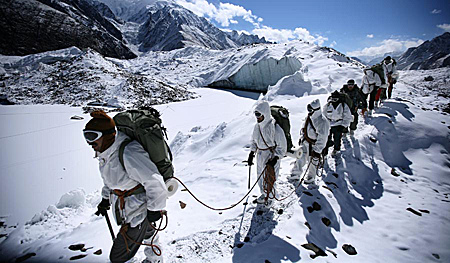SRINAGAR, May 29: India and Pakistan may have no plans of calling off their troops from Siachen glacier, but it seems that the arena itself may not be there in future. The world’s highest battlefield has vanished by half, at least on the Indian side, an Indian researcher says.
Geological field evidence has established for the first time that the original length of the 19,000-feet high Siachen Glacier was 150 kilometres. And now it is down to 74 kilometres.
“There is now evidence that global warming has caused the Siachen Glacier to recede by at least 76 kilometres— and this doesn’t include its other tongues and territory in Pakistan,” Dr. Rajeev Upadhay, of the geology department at Nainital’s Kumaun University says.
That melting process could touch the lives of millions across Pakistan, where much of the lifeline Indus River is fed by waters from the Nubra and Shyok rivers that originate from the Siachen and a tributary glacier called Rimo.
Melting of glaciers — slow-moving rivers of ice — can cause flooding, landslides and lakes that can burst, like Tibet’s Parchu Lake in June 2005.
Upadhyay, whose paper on his findings has appeared in the journal Current Science, has studied the glacier since 1995.
At Siachen artillery fire doesn’t rage now, but several thousand Indian and Pakistan soldiers are still deployed at Siachen, the site of one of the border disputes between the two countries. In April last, 139 people-all soldiers besides 8 civilians- were buried under a very large avalanche and only two bodies have been found so far.
Upadhyay shrugged off the view that military activity in the region has caused all the damage.
“The military presence has been there for two and a half decades. Artillery shelling certainly had some effect, but I have not seen any physical evidence in my visits of such swift damage,” he says. The findings are based on his visits to the region in 1995, 1996, 2002 and 2008 in the Nubra — Shyok river valleys and the adjoining Karakoram Mountains.
“I found signs of lateral moraines — debris on the sides of the glacier up to 600 metres high where thick ice sheets of the glacier would have been earlier,” Upadhyay says. He added that rocks were polished or had grating marks, signifying that the glacier ran through there earlier. “If this trend continues and snowfall keeps reducing, the glacier will vanish one day,” Upadhyay says.










